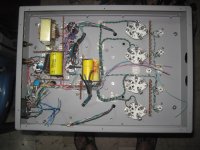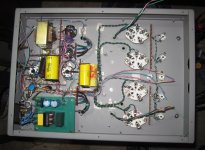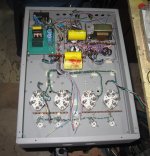Ideally, yes... but as Shoog said the dual CCS is a good workaround. And Broskie has written a bunch on the subject, e.g., https://www.tubecad.com/2011/08/blog0210.htmPlease help me to understand this. Does it need ideally matched tubes to work?
The pot should have a low value, say 10Ω, which would not degrade the differential function (much). Not sure you really need a bypass cap, as it is only used to set the idle bias.I think that for any reasonable pot value the differential function is degrated. Perhaps a bypass cap should be used here also?
The two CCS's allow the cathodes to float to whatever voltage allows the passage of the DC currents. This means the cathodes will likely be at different bias values. This is not particularly important since the back to back caps will prevent a DC flow from one cathode to the other. Think of the two halves as been isolated for DC purposes.
The high impedance of the CCS prevents any AC signal passing to earth through them - the only path remaining for the AC signal is the relatively low impedance presented by the back to back capacitors and the plate impedance of the opposite valve (and the very low impedance of the PSU). Since the signal going down from one side can only ever go up the other side the signal must be absolutely equal (but opposite) between the two valves at AC. Its a tug of war with no slack in the rope and the overall signal is a compromise between the signal trying to be amplified by each half of the PP pair.
This is the very definition of a LTP.
There literally cannot be any other behaviour and the effect is to squeeze out of the equation nearly all second harmonic distortion. This amp will not sound like an SE.
Let me just say that this back to back arrangement originates from the venerable old member of the forum Brian Beck and not myself.
Shoog
The high impedance of the CCS prevents any AC signal passing to earth through them - the only path remaining for the AC signal is the relatively low impedance presented by the back to back capacitors and the plate impedance of the opposite valve (and the very low impedance of the PSU). Since the signal going down from one side can only ever go up the other side the signal must be absolutely equal (but opposite) between the two valves at AC. Its a tug of war with no slack in the rope and the overall signal is a compromise between the signal trying to be amplified by each half of the PP pair.
This is the very definition of a LTP.
There literally cannot be any other behaviour and the effect is to squeeze out of the equation nearly all second harmonic distortion. This amp will not sound like an SE.
Let me just say that this back to back arrangement originates from the venerable old member of the forum Brian Beck and not myself.
Shoog
Last edited:
So, the two CCS's are set for equal currents so the OPT sees balanced DC. Clear now! Thanks Shoog!
The problem is that there is never a perfect solution for anything. Bypassing the CCSes, capacitors are introduced back, which Gary spent so much effort to eliminate.
They didn't have high performance CCS's back then - you can bet your bottom dollar that if they had they would have used them.
Shoog
Blessed are those that have faith...
Blessed are those that have faith...
Faith isn't really the issue.
They were an engineering firm and they would always have produced the product that produced the best measurable result. If they had a choice between a choke and a CCS they would have measured the result and chosen the CCS. They didn't have a CCS so they chose a choke over the inferior and wasteful alternative - a resistor.
There is no magic or romance in this and it isn't a ******* match - these are hard engineering decisions and the reason why Gary Pimm spent years perfecting the highest possible performing CCS's for audio use. If he hadn't there would be no Tabor design.
Chuck that away for the romance of Iron if you like.
Shoog
So, the two CCS's are set for equal currents so the OPT sees balanced DC. Clear now! Thanks Shoog!
I am not necessarily advocating this approach above a single CCS, but at least you now under4stand why it works. For me the ability to have an adjustment free amp far outweighs any theoretical drawbacks.
Make an informed decision based upon what works for you.
Shoog
A single CCS approach works equally as well but requires constant attention to bias balancing through some other mechanism such as independent screen adjustment.
idle output tube bias balancing is done via the input long tail pair G2 adjustments, and resistors at the plates of the 1624 are used to monitor plate currents
Screen adjustment should be cheaper since you don't need a high power wire wound pot like you would in the cathode's.
Shoog
agreed and this makes sense...
So, the two CCS's are set for equal currents so the OPT sees balanced DC. Clear now! Thanks Shoog!
the reason i thought about separate CCS's is to avoid possible current hogging,
and that random tube selection can be done rather than selecting tubes that are reasonably well matched......i could be wrong...
BTW, the last news I've heard on Gary's progress with this design was that he replaced pentode driver with MOSFETs. I guess perfection will be achieved when output tubes are also replaced with MOSFETs.
He did make the Solid State Tabor.
Indeed and from what I heard it sounds significantly better than the tube version.He attributes this to a lack of physical resonance in the tubes.
The only issue for me is that those SS pentodes are quite complex to build and need big heatsinks.
Shoog
Yes, it's not a typical SS build, and might be even more expensive than the tube version.The only issue for me is that those SS pentodes are quite complex to build and need big heatsinks.
Shoog
i have made up my mind, i am using a cathode resistor bias on the 1624's....
paralleled 2 x 1k ohm resistors by passed by a 470uf/250v ecaps...
i will mount them on pcb's.....
for the input ltp's i have not decided yet on the 6BC5 or the 6GK5's. why those?
i have lots of them to choose from...
paralleled 2 x 1k ohm resistors by passed by a 470uf/250v ecaps...
i will mount them on pcb's.....
for the input ltp's i have not decided yet on the 6BC5 or the 6GK5's. why those?
i have lots of them to choose from...
Indeed and from what I heard it sounds significantly better than the tube version.He attributes this to a lack of physical resonance in the tubes.
The only issue for me is that those SS pentodes are quite complex to build and need big heatsinks.
Shoog
So, here we go: transistors are better than tubes.
- Status
- Not open for further replies.
- Home
- Amplifiers
- Tubes / Valves
- Tony's TABOR amp clone wannabe build log.....


